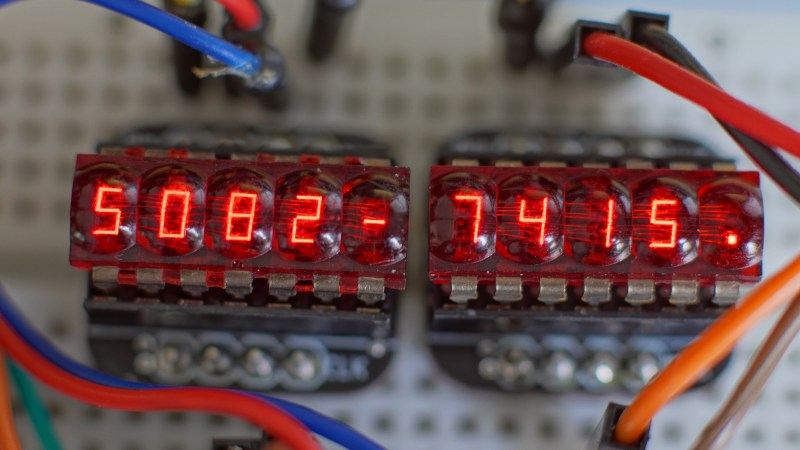For those of us who remember LED calculators, the HP 5082-7400 series red “bubble” displays hold a special charm. Available in 3, 4, or 5-digit varieties, these multiplexed 7-segment displays provided countless hours of entertainment to those who would spell upside-down words on their pocket calculators. In case you happen to be lucky enough to have access to a few of these beautiful vintage display sticks, [Gigawipf] has designed a small driver PCB that lets you easily interface them to a modern microcontroller.
At the heart of the board, aimed at either the 5082-7405 or 5082-7415 5-digit modules, are a pair of 74HC595 shift registers in tiny QFN packages. Five lines from one register drive one of the common cathodes for the selected digit, while the other register drives the eight anode lines through 330-Ohm resistors. The boards are slightly smaller than the width of the displays allowing you to stack them seamlessly for more digits, and eight header pins on each allow you to plug them into solderless breadboards for prototyping. The result is easy to drive with some simple code, and [Gigawipf] provides an example for Arduino as part of the project. The Eagle design files are supplied, as well as Gerbers for those who just want to have some boards made. This sounds like a great way to get some of these vintage displays going again.
If you can’t find any of these displays to play, with, you can try making some larger digits from individual surface-mount LEDs.















Interesting. But, ah, where did the author of this amazing idea find the displays for the activity? I found mine at a Hamfest last year. I know they are of the 5082-74XX series of displays. I believe they are part of the bubble display family that Sparkfun was selling two or so years earlier. (mine that is.)
The displays were found in long neglected storage bags in a university lab. Pins all bent and only half of them working perfectly which i did not know before.
They probably were in this bag for at least 30-40 years judging by the other parts there.
But before they are all completely broken i wanted them to be used again and made a few boards for me and a few if someone happens to find the displays again in 30 more years.
Sadly there are not many around anymore.
But i heard from some who still have a bunch of them unused and sometimes they pop up on ebay occasionally for pretty high prices.
Oh okay. Where did you find the data blurb for them? I am still looking for something that’s close for my crowd.
You mean the datasheet?
One potential source might be old TI-30 calculators from Ebay (quite inexpensive!) – they had a similar display, but I am not sure they are identical.
The TI-30 was much more integrated, with the display built in to the PCB. It could still be cut apart and driven separately, but would require quite a bit more hacking than these nice DIP display modules.
Holy shit these are like $40 ea on ebay.
I think I have a handful of these in the shed. Time to sell!
I found a lot of them on pomaroni’s site a while back. I bought half the lot, cost me around 15-20$
I made a clock out of one of them, pretty cool little buggers.
Can you give us (or the tip line) details of the build?
It’s also located in my projects page. I’ll submit it to the hotline so you can check it out. I need to update the page.
Project : https://hackaday.io/project/49562-hp-bubble-clock
You can still get old Novus / National Semiconductor calculators with these bubble-LED displays on ebay for cheap. They were probably the most common calculators back in the late 70’s.
https://americanhistory.si.edu/collections/search/object/nmah_1363209
There’s a specific brand and model of these bubble displays you’ll have to fight extreme Star Wars fans to obtain. In the original “Star Wars” movie one of these displays was used on Luke Skywalker’s light saber, for the very practical reason that it slid perfectly into the Graflex flash holder’s mounting clamp and would stay put with the clamp lever closed.
More greebles!